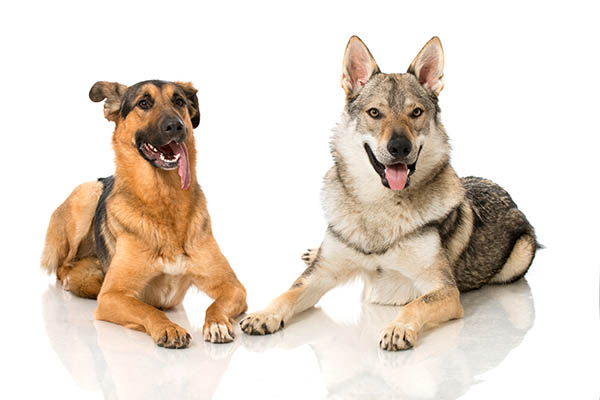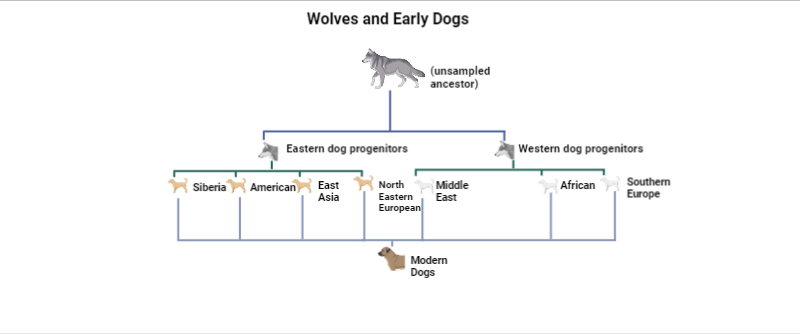
Popular topics

-
References
Bergström A et al. (2022). Grey wolf genomic history reveals dual ancestry of dogs. Nature 607, 313–320.
Hughes V. (2013). People and dogs: a genetic love story. Available at https://www.nationalgeographic.com/science/article/people-and-dogs-a-genetic-love-story Accessed 22/11/2022.
Ollivier M et al. (2016). Amy2B copy number variation reveals starch diet adaptations in ancient European dogs. R. Soc open sci 3, 160449.
Ollivier M et al. (2018). Dogs accompanied humans during the Neolithic expansion into Europe. Biol. Lett 14, 20180286.
Perri A R et al. (2021). Dog domestication and the dual dispersal of people and dogs into the Americas. Proc Natl Acad Sci USA 118, e2010083118.
Dogs: Wolves in Sheep’s Clothing?

What came first, the dog or the wolf? Man’s best friends may have slightly similar features to wolves, but they are different in temperament, behavior, and reputation. Since 2019, it was widely accepted by researchers that the ancestors of dogs are gray wolves (Canis lupus). How these wolves became domesticated, by whom, and how many times it occurred is not fully understood and there’s still no dogmatic answer to this. There are different theories as to the origins of modern dogs but a study by Bergström et al. has examined the DNA from ancient wolves, some of which had been preserved for as many as 100,000 years, to help answer how man’s most loyal friend may have derived from one of man’s most vicious rivals.
Born From the Wild
Many researchers strive to understand evolution and extinction. In the hunt for answers, the lack of study samples, sufficient information, and reliable results prevent a complete understanding of how wild animals became domesticated in the past. For example, regarding their connection to gray wolves, previous studies have shown different answers as to the domestication of dogs. Some researchers believe it happened 23,000 years ago in Siberia (Perri A R et al. 2020), but other studies have suggested it occurred later than that, or in regions such as Eastern Europe or Asia. This study by Bergström A et al. (2022) analyzed new and previously studied samples of wolf DNA, from preserved ancient wolves, found in regions across the globe, to try and piece together the origins of modern-day dogs.
A “Tail” as Old as Time
The study was led by more than 80 researchers at the Francis Crick Institute, London, UK. The team sequenced 72 ancient wolf genomes, including 66 ancient wolf genomes that had not been sequenced previously. Some of the samples were more than 100,000 years old, dating back to the Ice Age. The samples came from regions such as Europe, Siberia, and North America where preserved wolf remains have been found. Nine different research groups specializing in ancient DNA collaborated on sequencing the historical wolf genomes along with modern dog and wolf genomes to create an ancient genetic family tree. The study discovered that early dogs roughly 10,000 years ago had undergone domestication in not one but two different regions (Bergström A et al. 2022).

Fig 1. Genetic tree showing the association of early dog samples from approximately less than 10,000 years ago and two ancestral wolf populations. A, Early dogs from northern Europe, America, and Siberia seemingly obtained ~100% DNA from eastern progenitors and B, Early dogs from the Middle East, Africa, and southern Europe showed ~ 20-60% ancestry from another wolf source in Western Europe.
Dual Wolfpack
While some dogs were linked to ancient Western European wolves, others were also related to Middle Eastern and Eastern wolves. The wolf populations remained genetically connected during times such as the Late Pleistocene while trying to survive the end of the Ice Age. As expected, Eastern Eurasian wolves were the only single ancestral source of Siberian, American, East Asian, and North-eastern European dogs but another link was revealed in others. The study also found that Western Eurasian wolves contributed 20–60% of their DNA to early Eastern and African dogs. Likewise, it was discovered that 5-25% of these western progenitors existed in Neolithic dogs discovered to accompany humans during that time into Europe. (Bergström A et al. 2022, Ollivier M et al. 2018).
The study led to the creation of different hypotheses. Some concluded that the domestication of wolves may have occurred twice, independently in the two regions, before meeting to give rise to the dogs of today, or that domestication occurred in the East, and later on, mixed with western wolves as the animals moved around periodically and globally. The results could not fully distinguish between these two hypotheses due to a lack of genomes from other locations, as the technique relies on well-preserved DNA, and the conditions required for this means that preserved remains have only been found in certain regions. It was thought that the difficulty in obtaining ancient wolf samples, and a lack of specific genetic findings, meant the ancestors of current dogs were probably extinct. The study couldn’t support or reject this as none of the analyzed ancient wolf genomes were a direct match for either ancestry. With more information revealed about locations and domestication patterns, Anda Bergström from the study believes the samples needed to understand domestication are still hidden somewhere in Asia (Bergström A et al. 2022).
Additionally, the differences between dogs and wolves, external appearances may be associated with selection pressure developed from the need to survive harsh environments. Scientists have previously identified mutations in wolf species. That may have resulted from the high connectivity of the species during periods such as the Ice Age. Domestication could have brought about physical changes which were advantageous in the context of human interaction. For example, being tamed by humans offered more food and shelter to the wild hunting dogs than the wild (Ollivier M et al. 2016).
Taming Of the Wolf
Dogs differ from wolves in many ways for example floppy ears, decreased size of teeth, paws, and body, larger eyes, as well as increased alertness towards humans, including the ability to read people’s facial expressions (Hughes V. 2013). Wolves are also more fearful and fiercer in disposition than domesticated dogs. The scientific context behind some of these adaptations is revealed by genetic studies. A study focused on these phenotypic differences, compared the genetic sequences of modern-day dogs and wolves, and discovered distinct differences between the two, mostly revolving around two key functions; brain development, and starch digestion. This study is particularly interesting as one of the differences between dogs and wolves is changes in behavior and temperament, which might be associated with brain development and may be correlated to genetic changes that also affected the starch digestion mechanisms. If wolves wanted food from humans, both trust and a change in digestive processes would have occurred simultaneously leading to the domestication we see today in modern dogs (Ollivier M et al. 2016). Genetic sequencing plays a significant role in understanding studies like these and provides more insight into how humans also evolved and dealt with different climate and agricultural changes. (Hughes V. 2013, Ollivier M et al. 2016).
Still On the Hunt
So, what happens now with this information? The results from this study have shown interesting data that increases our understanding of the origins of the domestication of dogs. As this study provides new leads, scientists find themselves wagging their tails in excitement with the potential to answer what makes a predator change, why evolution favors domestication, and how does this help us understand more about our connection to animals and our evolutionary history? The questions are endless, but the scope for knowledge is wide. For now, dogs have left the wolf pack and joined us at our sides, continuing to be both fiercely protective and loyal as the wolves they used to be many years ago.
Want Answers to These Dogged Questions?
Bio-Rad has a range of canine antibodies and resources to help you stay one step ahead in your research.
References
Bergström A et al. (2022). Grey wolf genomic history reveals dual ancestry of dogs. Nature 607, 313–320.
Hughes V. (2013). People and dogs: a genetic love story. Available at https://www.nationalgeographic.com/science/article/people-and-dogs-a-genetic-love-story Accessed 22/11/2022.
Ollivier M et al. (2016). Amy2B copy number variation reveals starch diet adaptations in ancient European dogs. R. Soc open sci 3, 160449.
Ollivier M et al. (2018). Dogs accompanied humans during the Neolithic expansion into Europe. Biol. Lett 14, 20180286.
Perri A R et al. (2021). Dog domestication and the dual dispersal of people and dogs into the Americas. Proc Natl Acad Sci USA 118, e2010083118.
You may also be interested in...

View more Veterinary or Science News blogs















